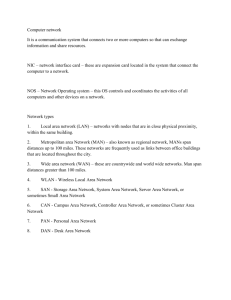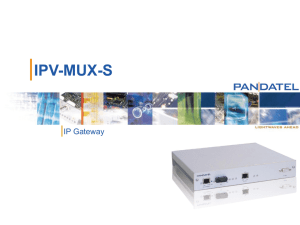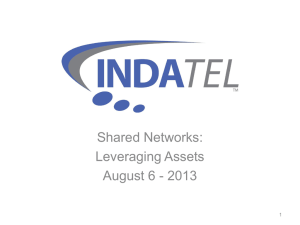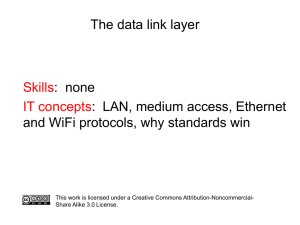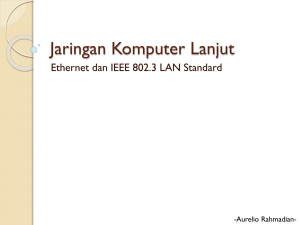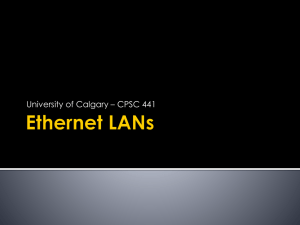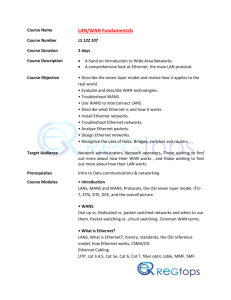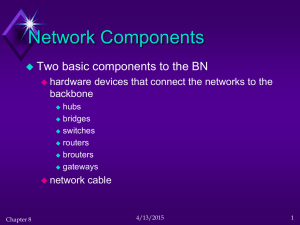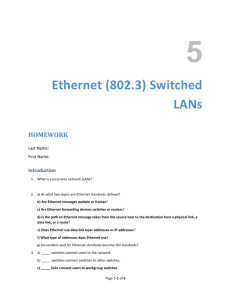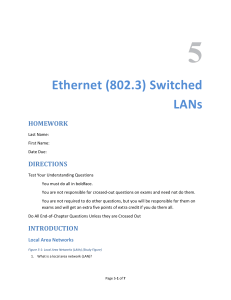Directions
advertisement
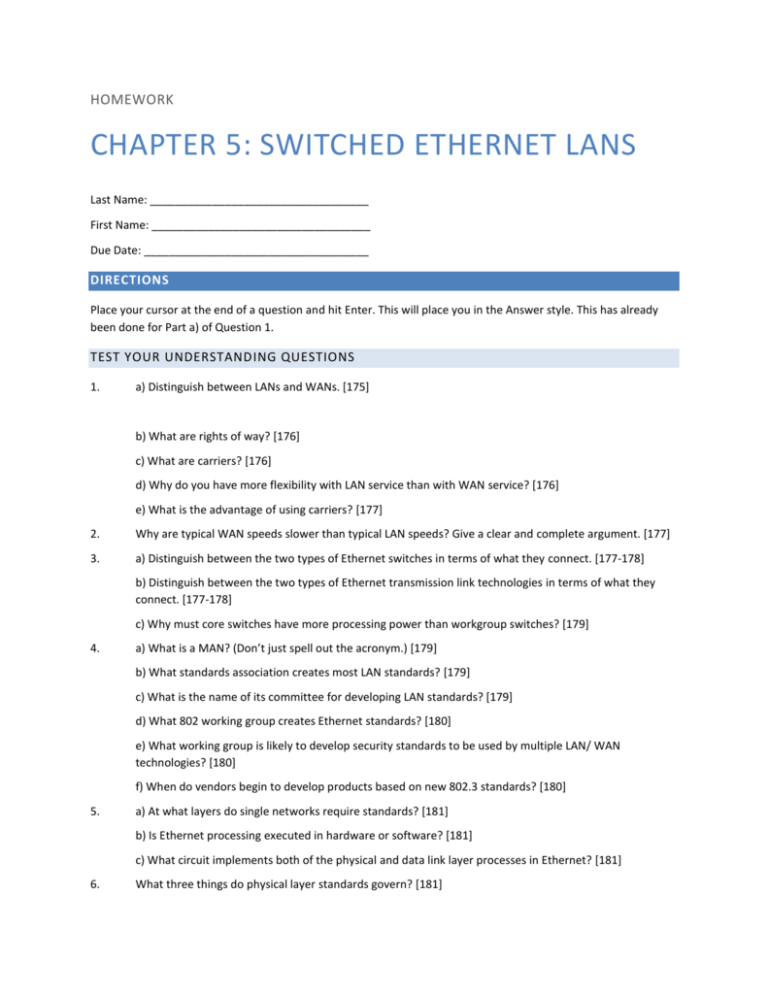
HOMEWORK CHAPTER 5: SWITCHED ETHERNET LANS Last Name: ___________________________________ First Name: ___________________________________ Due Date: ____________________________________ DIRECTIONS Place your cursor at the end of a question and hit Enter. This will place you in the Answer style. This has already been done for Part a) of Question 1. TEST YOUR UNDERSTANDING QUESTIONS 1. a) Distinguish between LANs and WANs. [175] b) What are rights of way? [176] c) What are carriers? [176] d) Why do you have more flexibility with LAN service than with WAN service? [176] e) What is the advantage of using carriers? [177] 2. Why are typical WAN speeds slower than typical LAN speeds? Give a clear and complete argument. [177] 3. a) Distinguish between the two types of Ethernet switches in terms of what they connect. [177-178] b) Distinguish between the two types of Ethernet transmission link technologies in terms of what they connect. [177-178] c) Why must core switches have more processing power than workgroup switches? [179] 4. a) What is a MAN? (Don’t just spell out the acronym.) [179] b) What standards association creates most LAN standards? [179] c) What is the name of its committee for developing LAN standards? [179] d) What 802 working group creates Ethernet standards? [180] e) What working group is likely to develop security standards to be used by multiple LAN/ WAN technologies? [180] f) When do vendors begin to develop products based on new 802.3 standards? [180] 5. a) At what layers do single networks require standards? [181] b) Is Ethernet processing executed in hardware or software? [181] c) What circuit implements both of the physical and data link layer processes in Ethernet? [181] 6. What three things do physical layer standards govern? [181] 7. a) What must a sender do to send the bits of a frame over a transmission medium? [181] b) Distinguish between binary and digital signaling. [181] c) What is a state? [181] d) Why is binary transmission error-resistant? [182] e) In Figure 5-7, how much could the signal attenuate before it became unreadable? [182] f) Why is binary digital transmission error-resistant? [183] g) How does error resistance differ in binary and digital signaling? [183] h) Why are clock cycles necessary? [183] i) If the binary transmission rate is 50 Mbps, how long will a clock cycle be? [183] 8. a) What type of copper wiring is widely used in Ethernet? [184] b) How many wires are there in a UTP cord? [184] c) How many pairs? [184] d) What type of connectors and jacks does 4-pair UTP use? [185] e) What is the advantage of parallel transmission compared to serial transmission? [185] 9. a) List the three main propagation effects that can impair a signal travelling through UTP wire. [186] b) List the two ways in which these effects are controlled. [186] c) Which types of propagation effects are controlled by which control method? [186] d) Why is terminal crosstalk interference the main type of interference problem? [186] 10. a) Of what wire characteristic is category a measure? [187] b) What types of UTP wiring can carry signals 100 meters at 1 Gbps? [187] c) What types of UTP wiring can carry signals in 10GBASE-T? [187] d) Which can carry 10Gbps Ethernet 100 meters? [188] 11. a) Does the signal travel through the optical fiber core, cladding, or both? [188] b) Why can signals travel very far through optical fiber? [188] c) Why does an optical fiber cord have two strands? [188] d) What is the ability to transmit in both directions simultaneously called? [188] e) Why does modal dispersion happen? [189] f) When will modal dispersion be a problem? [189] g) What is the measure of multimode optical fiber quality? [190] h) In what units is modal bandwidth expressed? [190] i) If you use 1000BASE-SX fiber, what modal bandwidth do you need to transmit a signal 250 meters? [190] j) Will light travel farther in 50 micron fiber or 62.5 micron fiber? [190] k) What does wavelength measure?[190] 12. a) Comparing LAN and WAN fiber, what are distance limits? [192] b) What light wavelengths are used? [192] c) What are the two diameters for multimode fiber? [192] d) What is the diameter of single-mode fiber? [192] e) What are the principle distance limiting factors for LAN and carrier fiber? [192] f) Is modal bandwidth a quality measure for LAN fiber, carrier fiber, or both? [192] 13. a) What is link aggregation? [192] b) What is it also called? [192] c) If you need to connect two 1000BASE-SX switches at 2.5 Gbps, what are your options? [193] d) Why may link aggregation be more desirable than installing a single faster link? [193] e) Why may link aggregation not be desirable if you will need several aggregated links to meet capacity requirements? [193] 14. a) What steps would you go through to use the information in Figure 5-12 and Figure 5-15 in network design? [194] b) If more than one type of Ethernet standard shown in Figure 5-12 and Figure 5-15 can span the distance you need, what would determine which one you choose? [194] c) In Figure 5-12 and Figure 5-15, is the maximum distance the maximum distance for a single physical link or for the data link between two hosts across multiple switches? [194] d) At what layer or layers is the 802.3 100BASE-TX standard defined—physical, data link, or internet? [194] e) How does regeneration allow a firm to create LANs that span very long distances? [194] f) If you need to span 300 meters by using 1000BASE-SX, what options do you have? (Include the possibility of using an intermediate switch.) [194] g) How would you decide which option to choose? [194] 15. a) What is the purpose of the preamble and start of frame delimiter fields? [195] b) Why are Ethernet addresses called MAC addresses or physical addresses? [196] c) What are the steps in converting 48-bit MAC addresses into hex notation? [196] d) Convert 11000010 to hex. [196] e) Convert 7F hex to binary. [196] f) The length field gives the length of what? [197] g) If the length field is 1020, what is the length of the packet in the data field? [197] h) What are the two components of the Ethernet data field? [197] i) What is the purpose of the LLC subheader? [197] j) What type of packet is usually carried in the data field? [197] k) What is the maximum length of the data field? [197] l) Who adds the PAD field—the sender or the receiver? [198] m) Is there a minimum length for the data field? [198] n) If the data field is 40 octets long, how long a PAD field must the sender add? [198] o) If the data field is 400 octets long, how long a PAD field must the sender add? [198] p) What is the purpose of the Frame Check Sequence Field? [198] q) What happens if the receiver detects an error in a frame? [198] 16. a) Do switches know the entire data link between the source and destination host? [199] b) What does a switch know? [199] c) In Figure 5-22, trace everything that will happen when Host E5 sends a frame to D4. [199] d) Trace everything that will happen when Host E5 sends a frame to B2. [199] 17. a) How are switches in an Ethernet LAN organized? [200] b) Because of this organization, how many possible paths can there be between any two hosts? [200] c) In Figure 5-23, what is the single possible path between Client PC 1 and Server Y? [200] d) Between Client PC 1 and Server X? [200] 18. a) What is the benefit of having a single possible path? Explain in detail. [201] b) Why has Ethernet become the dominant LAN technology? [201] c) Why are routers expensive for the traffic volume they handle? [201] 19. a) What is a single point of failure? [202] b) Why is having a single possible path between any two hosts in an Ethernet network dangerous? [202] c) What is the traditional way to address this problem? How does it bring redundancy? How does it improve reliability? [202] d) What standard allows backup links for redundancy in Ethernet networks? [203] e) Is it easy or difficult to create backup links effectively with RSTP? [203] 20. a) What is a VLAN? [204] b) What two benefits do VLANs bring? [204] c) How do VLANs bring security? [205] d) When VLANs or priority is used, what two fields does the 802.1Q standard add to Ethernet frames? [205] e) When VLANs are used, what does the Tag Protocol ID field tell a receiving switch or NIC? [205] f) What information does the tag control information field tell the switch or receiver? [205] g) In Figure 5-27, what server or servers can Host A communicate with? [205] h) In Figure 5-27, what server or servers can Host C communicate with? [205] 21. a) How many priority levels are possible for Ethernet switches? [206] b) Why does a momentary traffic overload cause delay? Be specific. c) How does priority reduce delay? d) What determines what level of priority a frame will be given? e) What priority would you give to streaming video? Defend your decision. f) What priority would you give to database queries? Defend your decision. g) What is the trade-off between implementing priority and overprovisioning? 22. a) What are managed switches? [207] b) What benefits do they bring? [207] c) Do managed switches increase or decrease total costs? [207] d) Why does a company’s security level determine whether it can use the Set command? [208] e) What are the implications of not being able to use the Set command? [208] 23. a) What is POE? [208] b) Why is POE attractive to corporations? [208] c) What maximum standard power does the POE standard specify? [209] d) For what types of devices is POE sufficient? [209] e) Is POE sufficient for desktop computers and most notebook computers? [209] 24. a) What threat does 802.1X address? [210] b) How does the standard address the threat? [210] c) In 802.1X, what device is the authenticator? [210] d) What are the benefits of using a central authentication server instead of having the individual authenticators do all authentication work? [210-211] 25. a) What is likely to be the main standard for 100 gigabit per second Ethernet? [211] b) At what speed does 100GBASE-SR10 operate? [211] c) What is the speed of the 100GBASE-SR10 virtual lane? [211] d) What is the speed of an individual 100GBASE-SR10 media lane? [211] e) How many optical fiber cords does 100GBASE-SR10 require? [211] f) How many connectors does 100GBASE-SR10 require at each device? [211] g) Why is 100GBASE-SR10 better than simply trunking ten 10GBASE-SX connectors on each device? (Explain your answer.) [212] h) How are 100 Gbps standards likely to change for LANs as technology matures? [212] END-OF-CHAPTER QUESTIONS THOUGHT QUESTIONS 1. With power over Ethernet, what is the potential danger to users in having powered switch ports? How do you think this danger might be avoided? [208-209] 2. When would the optional Tag fields in the Ethernet frame be added? [205] 3. The Length field is 22. a) How long is the combined data field and PAD? [197-198] b) How long is the PAD? [197-198] DESIGN QUESTIONS 1. Design an Ethernet network to connect a single client PC to a single server. The two devices are 410 feet apart. They need to communicate at 800 Mbps. Your design will specify the locations of switches and the transmission line between the switches. 2. Add to your design in the previous question. Add another client next to the first client. This client will also communicate with the server and will also need 800 Mbps in transmission speed. Again, your design will specify the locations of switches and the transmission line between the switches. TROUBLESHOOTING QUESTION 1. You are connecting two switches in a large Ethernet switch with 32 switches. You are using 4-pair UTP. Suddenly, transmissions cannot travel over the network. What do you think might have happened? If you cannot come up with a good solution, reread the synopsis and see which points might apply.
